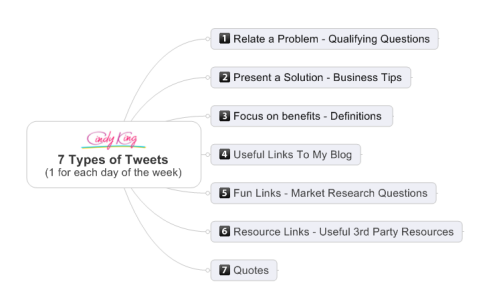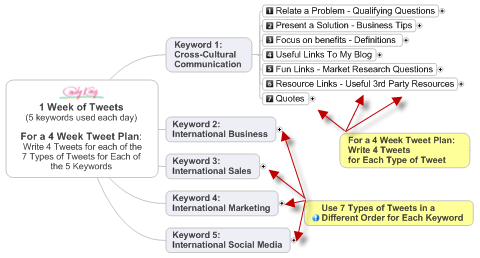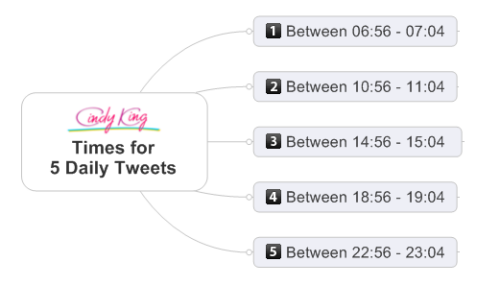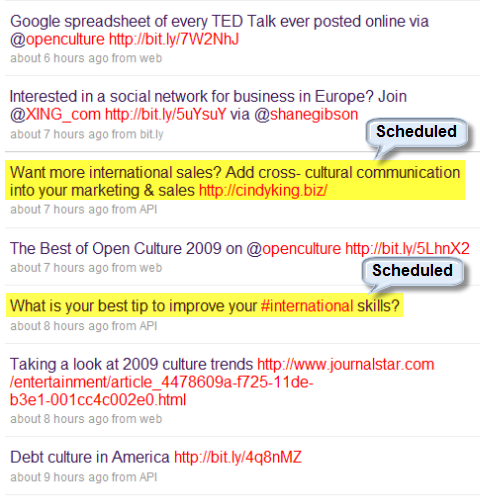 Are you using Twitter and wondering whether it's doing anything for your business?
Are you using Twitter and wondering whether it's doing anything for your business?
Do you have a strategy? Or do you find yourself haphazardly tweeting at all hours of the day about everything from what you had for breakfast to news in your industry?
If so, you need a tweet plan.
What Is a Tweet Plan?
A tweet plan is a series of scheduled tweets used in conjunction with your real-time tweeting. The tweets in your tweet plan are carefully crafted to target your preferred audience. The result: Every day you consistently brand your Twitter presence and attract the attention of the people you want to reach, providing them useful information.
And because your tweets are evergreen, they can be scheduled in advance. This means you only spend a couple of hours writing and scheduling up to 4 weeks' worth of tweets at a time. Here's how it works:
Why You Should Use a Tweet Plan
There are three main advantages to a tweet plan.
A tweet plan brands your Twitter presence. Your audience immediately knows what you want to talk about, even when your Twitter discussions take you slightly off topic or you become busy with other things.
A tweet plan brings consistency. Even when your schedule gets busy, you will still share valuable information on Twitter.
A tweet plan saves time. You can write your tweets at your own convenience and schedule them to be tweeted up to 4 weeks later.
8 Steps to Creating Your Tweet Plan
Step 1: Choose Your Preferred Audience
Before you begin crafting your tweet plan, give some thought to whom you want to connect with on Twitter. There are many different types of people who could help your business. You will probably have best results if you choose just one or two. This is your preferred Twitter audience. Here are some suggestions:
- Prospects: Find out more about what people want and connect with them early in your sales cycle
- Clients: Find new customers ready to buy your product or service and provide customer support
- Referral sources: Reach out to people who can help your business find more clients
- Joint venture partners: Find other peers and research opportunities
- Business network: Keep your business network alive and share ideas
- Suppliers: Network to find suppliers and stay up-to-date with industry news
Step 2: Decide How Many Tweets You Want to Send Daily
Before writing your tweets, you need to decide how many timeless tweets you want to publish each day. You will base your decision on:
- Your current Twitter presence and how many real-time tweets you usually send each day
- Your audience and what they like. You are going to provide your preferred audience with content they want, so this is more a question of how much time they have for you
The important thing to remember is that your tweet plan only provides a backbone of tweets. It should not become your sole source of tweets on a regular basis.
Many people aim for a total number of about 20 tweets a day including both scheduled tweets and real-time tweets. In this case, a good number of timeless tweets to start with in your tweet plan would be 3 to 5.
Here's an example. If you have 20 tweets a day on average and only 5 of these 20 tweets are from your tweet plan, you still have 15 tweets to engage with your followers and to respond to current news.
Get World-Class Marketing Training — All Year Long!
Are you facing doubt, uncertainty, or overwhelm? The Social Media Marketing Society can help.
Each month, you’ll receive training from trusted marketing experts, covering everything from AI to organic social marketing. When you join, you’ll also get immediate access to:
- A library of 100+ marketing trainings
- A community of like-minded marketers
- Monthly online community meetups
- Relevant news and trends updates
Important: The tweet plan's main purpose is to get you on the radar of the people you are most interested in reaching. You still need to engage with your audience.
Don't make the mistake of relying solely on the scheduled tweets in the tweet plan to connect with people and expect to build your business. You still need live tweets to engage with people. Live tweets help you to connect with people in a way that brings them beyond Twitter and leads them along the path you want to take with them.
Step 3: Decide How Long You Want to Make Your Tweet Plan
After deciding how many tweets you want to put in your tweet plan each day, you need to decide how many weeks you want to run your tweet plan and schedule tweets in advance. Again, this will depend on certain business factors and your audience. The two important considerations:
- How much time you have
- How quickly you can process the feedback you get from your audience to include in your next tweet plan
My preference: As a freelancer, I particularly like a 4-week tweet plan. This means once a month I spend an afternoon revising and scheduling my tweets. After 4 weeks, I have more insights and feedback that I'm eager to include in the next tweet plan to create a stronger connection with my market.

Discover Proven Marketing Strategies and Tips
Want to go even deeper with your marketing? Check out the Social Media Marketing Podcast! Publishing weekly since 2012, the Social Media Marketing Podcast helps you navigate the constantly changing marketing jungle, with expert interviews from marketing pros.
But don’t let the name fool you. This show is about a lot more than just social media marketing. With over 600 episodes and millions of downloads each year, this show has been a trusted source for marketers for well over a decade.
Step 4: Find the Keywords You Want to Use on Twitter
You use keywords in your tweets to send a consistent signal to tell others who you are, how you want to connect with them and what you want to talk about.
Choice of keywords. When choosing the keywords to use in your tweet plan, remember your preferred audience, the people you most want to connect with on Twitter. You want to use the keywords they use.
Number of keywords. The easiest way to write your tweet plan is to choose the number of keywords to correspond with the number of scheduled tweets you want to publish each day. So if you decide on 5 daily tweets in your tweet plan in Step 1, you should try to come up with 5 keywords.
This means your scheduled tweets will provide your preferred Twitter audience with useful information every day on each of these 5 keywords.
Suggestion: When choosing your keywords, keep Twitter's 140 character limitation in mind. Use short words or word strings.
Step 5: Choose Different Formats for Your Scheduled Tweets
When you sit down to write your tweets for your tweet plan, you will need to write many in one sitting. Here's the math:
- 5 timeless tweets a day x 7 days a week = 35 tweets a week
So, if you decide to plan 4 weeks of tweets, you will need to write 140 unique tweets.
- 35 tweets a week x 4-week tweet plan = 140 tweets
This is a large number of tweets. So you want to make the task easy. Using different formats helps you to do this. You will be able to write many timeless tweets on the same keywords when you use different formats.
Another good reason to use different formats when writing your timeless tweets is to add variety. You don't want your Twitter feed to become boring.
My preference: I use 7 different formats and schedule one for each day of the week. I also increase the variety and experiment with results by changing the order in which these tweets are published each week. Here's a snapshot from one of my tweet plans:

Step 6: Write Your Timeless Tweets
You want to write your tweets to provide your preferred audience with the information they are most interested in. Each tweet must be unique content because Twitter does not allow duplicate tweets.
This next step of writing a series of unique tweets is simple if, for each tweet, you:
- Keep your preferred audience in mind
- Use one of your keywords
- Use one format to write your tweet
If you have chosen to use 7 different formats for your tweets, all you need to do is to write the number of weeks of tweets for each variation of keyword + format. For a 4-week tweet plan you will need something like this:

Tip: Use good Twitter practices when writing your tweets. Remember to include hashtags and limit your tweets to 120 characters to make it easy for others to retweet.
Step 7: Choose Your Times
You don't want to publish all of your scheduled tweets at once. This does not look “natural” in your Twitter feed and you would only reach the audience online at that time. You want to spread your tweets out throughout the day. Ideally you will also be publishing the majority of your tweets in real time. By spreading out your scheduled tweets, they will appear in between the other tweets in your Twitter feed.

Tip: Make note of the hours you use for your different keywords in each tweet plan. This allows you to test the best times for your different keywords the next time you schedule your tweet Plan.
Step 8: Schedule Your Tweets
Now it's time to schedule the publication of your tweets at the times you have chosen.
There are many tools available to do this. The two most popular ones are SocialOomph and Hootsuite.

Tip: Keep your list of tweets and refer to it along with the feedback you get from interactions with your preferred audience on Twitter to craft your next tweet plan.
Is a Tweet Plan for You?
Although a tweet plan is useful when your schedule gets busy, it's not a way to avoid real-time tweeting. The tweet plan's main advantage is to maintain brand awareness consistently and attract the people you want to meet on Twitter.
But there are different opinions about scheduling posts. Many people feel scheduling tools take away from the value of real-time interaction on Twitter. And they are right.
You must find a balance to make this work for your business. And you can only find this balance by jumping in, listening to your audience and tweaking the content you share on Twitter to get the best results.
What do you think? Would your business find value in using these scheduling tools strategically?
Attention Agency Owners, Brand Marketers, and Consultants

Introducing the Marketing Agency Show–our newest podcast designed to explore the struggles of agency marketers.
Join show host and agency owner, Brooke Sellas, as she interviews agency marketers and digs deep into their biggest challenges. Explore topics like navigating rough economic times, leveraging AI, service diversification, client acquisition, and much more.
Just pull up your favorite podcast app, search for Marketing Agency Show and start listening. Or click the button below for more information.

